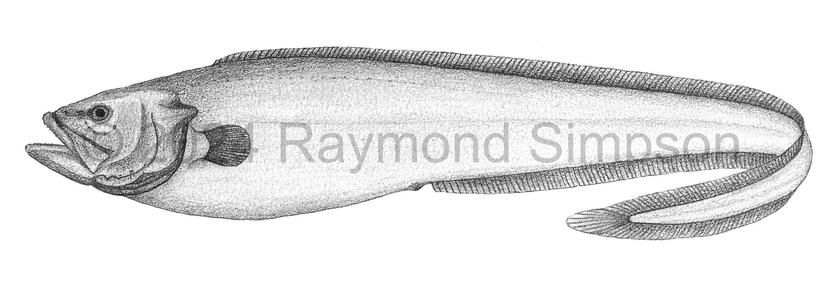
Common Name
Violet Cusk-eel
Year Described
Parr, 1934
Identification
Dorsal Fin: 119-134
Anal Fin: 98-108
Pectoral Fin: 22-26
Caudal Fin: 9
Pelvic Fin: 0
Gill Rakers: 3+1+7 on first arch (14 tubercles)
Vertebrae: 13-15 (precaudal), 88-96 (total)
Body elongate and compressed. Head large but body more elongated and tapering (head 5.3-8.5 times in SL). Snout longer than eye. Mouth large, extending past orbit. Teeth present in vomer, palatine, dentary, and premaxilla. Maxilla expanded rearward. Head sensory pores and canals well developed. Opercle with no spine. No median basibranchial tooth patch. Gill rakers with spiny tubercles. Pectoral fin small. Pelvic fin absent. Body, head, and fleshy bases of fins fully scaled. Scales are randomly distributed star-shaped prickles. Otoliths very small and round.
Color
Body a striking shade of lilac to pale purple (dead fish fade to whitish). Extensive dark pigment on head, around mouth, gill cover and eyes is variable. Area on base of dorsal and anal fins gray to purplish-gray. Fins dark gray.
Size
Maximum size to at least 860mm SL.
Habitat
Apparently a midwater species captured no deeper than 800m.
Range
Bermuda to the S. Caribbean Sea.
References
Cohen, D. M. 1974. A review of the pelagic ophidioid fish genus Brotulataenia with descriptions of two new species. Zoological Journal of the Linnean Society, 55(2), 119-149.
Fahay, M. P., & J. G. Nielsen. 2003. Ontogenetic evidence supporting a relationship between Brotulotaenia and Lamprogrammus (Ophidiiformes: Ophidiidae) based on the morphology of exterilium and rubaniform larvae. Ichthyological Research, 50, 209-220.
Other Notes
The only other long-bodied Brotulotaenia species is B. nigra, which differs in body proportions and coloration.